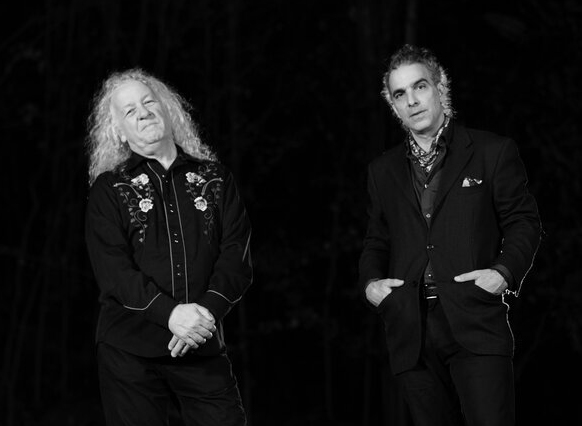photo credit: Broady Photography
From mutual admirers to friendship then songwriting partnership, the musical project Cedar Sparks is what happens when Tim Carbone (Railroad Earth) and Lou Rogai (Lewis & Clarke) find time away from their busy schedules involving other bands, studio work and family life to collaborate. Since 2017, that’s resulted in four intriguing gothic folk tracks featuring lyrical depth and sweeping musical drama.
Conveniently, both share studio space in The Castle Inn, a historic building steeped in a century of music history near their homes in Delaware Water Gap, Pennsylvania. Inconveniently, the COVID pandemic has held up finishing more material despite both musicians not touring this year. They agree that their type of music needs to be created with musicians together in a room under natural elements rather than sharing files.
Cedar Sparks’ debut found the duo adapting a passage from James Joyce’s literary classic Finnegans Wake for the Waywords and Meansigns project, which curated three editions of the book set to music. Prior to that, Rogai engineered Carbone’s solo recording for that project.
Inspired by It’s A Wonderful Life, seasonal depression and the commercialization of Christmas, the following year Cedar Sparks released an all-inclusive holiday number, “Gathering Song.”
Now, the history revolving around their homebase has influenced the duo’s latest — the single “Maggie”/”Blood on the River.” Based on true events, the murder ballads address the crime and punishment that took place circa 1883 in nearby Easton PA. Written in the first-person perspective of Charles Getter, a delusional psychopath who believes he’s acting out of love, “Maggie” finds him charming his bride-to-be. On “Blood in the River” after he murders her (and their unborn child), he professes his love for his victim from the gallows above the Delaware River.
Carbone pointed out during a zoom interview with the two musical partners that the songs were released to garner listeners’ interest and subsequently encourage him and Rogai to finally complete unfinished material.
JPG: I recently interviewed Painted Shield in a Zoom interview. It was actually my third done that like that. How do you like doing interviews this way?
TC: I think it’s pretty cool.
LR: Yeah. I like it. I agree.
TC: It would be so great if it could be used as a tool to collaborate with other musicians. I’ve tried it a couple of times and it’s kind of a nightmare.
LR: Tim and I have been talking about maybe trying to trade some chord ideas and I think we should still pursue it a little bit more. We talked about how it’s not the same as being in the room together and doing the chill together and absorbing energy. But, if this is the tool we have to stay safe with, then I’ll still try it.
TC: It might be different when you’re in a writing situation where you create ideas. You don’t necessarily have to play together. You can go, “What if I did this?” Most of it looks like the audio gets interrupted when someone else starts talking. So, it’s a little scattered.
JPG: In Painted Shield’s situation, because the band members lived in different cities they were sharing files and never were in a studio together. That was before the whole socially- distant protocols came about in 2020. For them it worked.
TC: I share files all the time. That’s how I pay for the studio. People give me files and I’d lay something down on it and I send the files back. It’s essentially the same thing.
LR: It’s like sending a tape in the mail. The Postal Service came out had the literal postal service trading, I think four track tapes and some analog eight-track tapes.
JPG: Here we are with Cedar Sparks, which actually has been putting out small tastes of music since 2017. Let’s go back to how the partnership came together.
TC: The first time I was aware of Lou I was in our local record store in Stroudsburg and I heard this music over the speakers in the store. And I was like, “Wow! That’s cool. What’s that?” And he said, “That’s Lewis & Clarke. You don’t know Lou Rogai?” And I was, “No, I don’t. I guess I should.” I hadn’t for some reason. Up until that point, we hadn’t really crossed paths. That had to have been maybe eight years ago or something like that. I’m not sure. It was before I had my studio.
LR: In 2014 I was releasing a Lewis & Clarke record at that time and I saw you the day that we were setting up the show in the museum here in Delaware Water Gap, where we live. Tim came by with Don Sternecker, the engineer, who is part of our studio spaces, collaboration in this building we’re all in. He came by and I was, “I need an extra mic.” And he said, “Let me call Tim.” Then, Tim came over with a mic and he was like, “Hey, I have your records.” And I said, “I listen to Railroad Earth. I never knew what you looked like.” Essentially neighbors who had never met for all these years.
TC: He lives next to my studio. I volunteered to babysit the sound while I got it up and going. They didn’t really need much, but once it was going, I just hung out and dug it.
JPG: That was rehearsal space was The Castle Inn, correct? You were both there and just never ran into each other?
TC: Lou wasn’t actually in the Castle. Obviously, he was well aware of the Castle but he hadn’t gotten the studio space until a little bit later. I was the first music guy on the third floor, which was unfinished. When you walk up there for the first time you look around and go, “Oh man, this is pretty bad.” All the rooms are unfinished and falling down. My room had water damage from the roof leaking and the rugs were rotten. That’s why the rent’s stupid cheap. If I told you how cheap it was, John, you’d be moving to Delaware Water Gap right now.
JPG: So, you were a mutual admiration society. Was it a matter that you got the call up to do the James Joyce “Finnegans Wake” track and that’s what finally got you together or did you have a jam session or writing session to see how this would work?
TC: We started playing in my studio. Lou’s the kind of guy; he’ll knock on the door, walk in the studio and pick up an instrument. Next thing you know, a song comes out. So, it happened organically that way. He would come in and sit down. Pick up one of the guitars and next thing you know, I’m sitting at the piano or I’m behind the drums. I have all kinds of stuff laying around, ready to pick up and play whenever you want. That’s kinda how it started.
The James Joyce thing was the first thing we did. I had done one on my own, a really long one. I read a whole chapter. Holy crap! That took a long time. What did we do? Three pages or four pages, something like that.
LR: That was cool because we were in the process. We didn’t know what we were doing. We were just playing music together with no agenda. Like Tim said, it was really organic. You had that call up for the James Joyce project and said, “You should do this with me because we can do all the musical things that we’re doing and then read to it.” That was such a fun experience. It becomes psychedelic or speaking in tongues when you’re reciting those words. That was next level.
TC: It’s insane. Actually, I got to the point where the one thing that I got out of that whole thing, even from the first time, and then even more so the second time was that “Finnegans Wake” and probably, I would almost say James Joyce in general has to be read out loud in a rhythmic sense to get it. I don’t think you can just read it on the page and go, “Oh yeah. I get that.” It doesn’t seem to work for me. Once I started reading, at first I was like, “Oh my God! I’m never going to be able to do this,” and stopping every 30 seconds. The other thing I’ve found is I have to kind of intimate an English accent, even though I suck at it. Then, all of a sudden it rolls off the tongue. It’s kind of weird.
LR: We were calling it Faux Brogue. That was how we first established something that was a finished product. From that point that we said, “Let’s do a proper songwriting collaboration.” Then, we just kept coming up with riffs and sometimes finishing pieces and sometimes not. Meanwhile, Tim’s touring the whole time with Railroad Earth and I’m working on my projects and my compositions and we’re doing our family things. So, we utilized what we started calling Cedar Sparks as a safe harbor to come back to, as a home base, because by that point I had rented the studio that I’m in now. Now, we’re on the same floor, two doors away and using that as a home base.
TC: Even though we’ve been doing this for three years or more, it’s sorta like inside my place, which is called Black Lotus. Inside Black Lotus, time and space is a little suspended.As far as I’m concerned, what we’ve created has been created over the course of maybe about a year. Outside of the studio time and space is real, it’s like three years has gone by.
LR: It gets like “Dune” with folding [of space] time. It has been the course of three years but we get to work on our stuff and, sometimes, we don’t work on stuff. Sometimes, we go for walks and talk about things and that’s really cool that it’s based off of a friendship and a like-mindedness.
I always told people that Tim was like the first mentor I’ve had. I’ve learned so much from setting up my studio from his recording and production experience; the things we have in common. I never had the big brother or the uncle type and Tim, you’re not that much older than me, but you’re like a big brother and a mentor to me. It’s a really cool thing. I’ve always been the person who leads the charge, so to speak. Collaborating in this way is a really refreshing thing for me.



1 Comment comments associated with this post
12/11/23 A Song About It’s a Wonderful Life and One About Scrooge | Tom's Christmas Music Blog
December 11, 2023 at 1:09 pm[…] It’s hard to describe the music of Cedar Sparks. On their instagram page they categorize their genre as 𝑭𝒐𝒍𝒌-𝑵𝒐𝒊𝒓 | 𝑮𝒐𝒕𝒉𝒊𝒄 𝑨𝒎𝒆𝒓𝒊𝒄𝒂𝒏𝒂. One reviewer calls it “Dark Americana.” […]